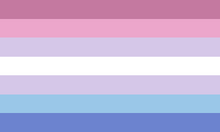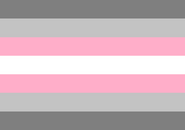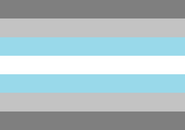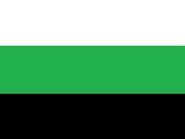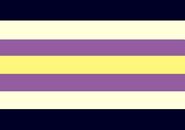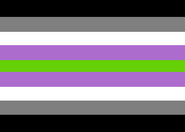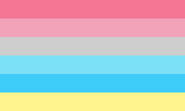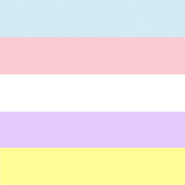(Editing a gallery) |
m (→Agender Flag) Tag: Source edit |
||
| (7 intermediate revisions by 4 users not shown) | |||
| Line 1: | Line 1: | ||
| − | '''Pride flags''' are a |
+ | '''Pride flags''' are a diverse set of flags that are used for representing a gender or sexual identity that is fully part of the LGBT community. |
| − | Pride flags are often carried out at pride parades and other visibility events to show identification or support for a particular [[gender identity]] or sexuality. They may also be combined with [[gender symbols]]. Read on to learn about the different flags in the trans, nonbinary, and genderqueer community. |
+ | Pride flags are often carried out at pride parades and other visibility events to show identification or support for a particular [[Gender identity|gender identity]] or [[Sexual Orientation|sexuality]]. They may also be combined with [[gender symbols]]. Read on to learn about the different flags in the trans, nonbinary, and genderqueer community. |
==[[Transgender]] Flag== |
==[[Transgender]] Flag== |
||
| Line 81: | Line 81: | ||
The two colors have been used alone to intentionally be agender specific without the addition of others usually seen to give reference to gendered identities of any type and aesthetically to create a stark, bold, and simple contrast for the emphasis in the difference and separation from genders expressed and included in other pride flags. |
The two colors have been used alone to intentionally be agender specific without the addition of others usually seen to give reference to gendered identities of any type and aesthetically to create a stark, bold, and simple contrast for the emphasis in the difference and separation from genders expressed and included in other pride flags. |
||
| + | |||
| + | [[File:Agender four stripes.png|thumb|Four-stripe agender flag by [https://agender.carrd.co AgenderInfo]]] |
||
| + | The four-stripe agender flag is colored (top to bottom) black, gray, white, and neon green. It was created by an agender transgender person as an homage to Salem's original flag, but with bolder stripes and a stronger green, and different color meanings. This flag is always flown with the black stripe on top, to distinguish it from the Aromantic flag, which also appears green, white, and black. The four-stripe agender flag emphasizes inclusion of agender people who may also be lesbian, gay, bi, nonbinary, trans, ace, etc., and their shared feeling of wholeness in genderlessness. |
||
| + | * Black for safety, the night sky, the void. |
||
| + | * Gray for cement and ashes. |
||
| + | * White for bones. |
||
| + | * Green for living, feeling agender. |
||
== [[Pangender]] Flag == |
== [[Pangender]] Flag == |
||
| Line 117: | Line 124: | ||
Agenderflag.png|alternate agender flag |
Agenderflag.png|alternate agender flag |
||
Genderflux.png|Genderflux flag |
Genderflux.png|Genderflux flag |
||
| − | Cisgender_pride_flag_2_by_flagsforcishets-dacot4k.jpg|[[Cisgender]] pride flag by FlagsforCisHets |
+ | Cisgender_pride_flag_2_by_flagsforcishets-dacot4k.jpg|[[Cisgender]] pride "flag" by FlagsforCisHets |
Doe Flag.svg|Pride Flag for Does, people whose identity or expression is feminine, without necessarily being women or femmes|link=https://www.deviantart.com/vergess/art/Doe-Flag-803223709?ga_submit_new=10%3A1561512321 |
Doe Flag.svg|Pride Flag for Does, people whose identity or expression is feminine, without necessarily being women or femmes|link=https://www.deviantart.com/vergess/art/Doe-Flag-803223709?ga_submit_new=10%3A1561512321 |
||
Littlefluid flag.png|Littlefluid pride flag by Bugfav |
Littlefluid flag.png|Littlefluid pride flag by Bugfav |
||
| − | Hebephilia Flag.png|Hebephilia Flag |
||
</gallery> |
</gallery> |
||
* more at [https://pride-flags.deviantart.com/gallery/55884919/Genders pride-flags deviantart]. |
* more at [https://pride-flags.deviantart.com/gallery/55884919/Genders pride-flags deviantart]. |
||
| + | |||
| + | ==See also== |
||
| + | [[Peace Flags]] |
||
[[Category:Culture]] |
[[Category:Culture]] |
||
| + | [[Category:Pride Flags| ]] |
||
Revision as of 19:08, 15 October 2020
Pride flags are a diverse set of flags that are used for representing a gender or sexual identity that is fully part of the LGBT community.
Pride flags are often carried out at pride parades and other visibility events to show identification or support for a particular gender identity or sexuality. They may also be combined with gender symbols. Read on to learn about the different flags in the trans, nonbinary, and genderqueer community.
Transgender Flag
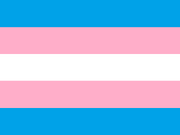
The transgender pride flag by Monica Helms
The current transgender flag was designed by trans woman Monica Helms in 1999. It has five stripes in total, from top to bottom: blue, pink, white, pink, blue. It first appeared a pride parade in Phoenix, Arizona in 2000. [1][2]
- The blue stripes represent men as blue is the traditional color for baby boys.
- The pink stripes represent women as pink is the traditional color for baby girls.
- The white represents those who don't neatly fit into the gender binary and intersex people, as well as representing the crossover between genders that many trans people feel they undergo in transitioning.
Nonbinary Flag
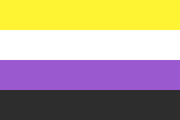
The nonbinary pride flag designed by Kye Rowan.
The nonbinary pride flag was created by 17 year old Kye Rowan in February of 2014 when a call was put out by several members of their community for a flag that could represent nonbinary folk who did not feel that the genderqueer flag represented them. This flag was intended to go alongside Marilyn Roxie's genderqueer flag rather than replace it. [3][4][5]
The flag consists of four stripes coloured (from top to bottom) yellow, white, purple and black.
- Yellow represents those whose gender exists outside of and without reference to the binary as yellow is often used to distinguish something as its own.
- White represents those who have many or all genders as white is the photological presence of color and/or light.
- The purple stripe represents those who feel their gender is between or a mix of female and male as purple is the mix of traditional boy and girl colors. The purple also could be seen as representing the fluidity and uniqueness of nonbinary people.
- The final black stripe represents those who feel they are without gender, as black is the photological absence of color and/or light.
Genderqueer Flag
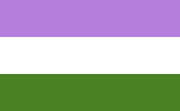
Genderqueer flag designed by Marilyn Roxie.
The final version of Marilyn Roxie's genderqueer pride flag was created in June 2011. It underwent two other versions with the same color scheme in 2010. It originally attempted to represent all non-binary and genderqueer people, however, as the genderqueer community grew the flag became synonymous with "genderqueer", thus leaving many non-binary people feeling forced under a label they didn't want. Rather than try to replace Roxie's flag, another flag has come to sit along side it to represent those who wanted it. [6]
The genderqueer flag has three stripes coloured (from top to bottom) purple, white and green.
- Chartreuse green represents those outside the gender binary as it is the inverse color to purple, the combination of pink and blue.
- The white stripe represents agenderness and gender neutrality.
- The third stripe is purple, to represent those whose genders are of, between, or a mix of female and male.
gender nonconforming/gender creative flag
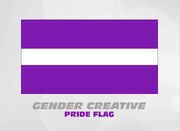
Designed by Leslie Ellen (sorcerykid)
Sorcerykid: "The banner is constructed of two exterior lavender fields in opposition, a composite of the pink and blue fields found in the transgender pride flag and an interior white field one-fifth the proportion to the remainder. Lavender symbolizes the blurring of the conventional ideals associated with masculinity and femininity whereas white represents freedom of gender expression."
Intersex Flag
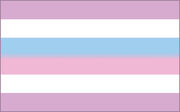
Intersex flag by Natalie Phox
An intersex flag was created in 2009 by Natalie Phox. It consists of five horizontal stripes coloured (from top to bottom) lavender, white, a double-width stripe with a gradient from blue to pink, white and lavender. The gradient represents the range of sexes between male and female, and the lavender represents a combination of male and female traits.
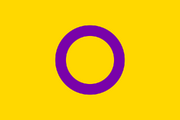
Intersex flag designed by Organisation Intersex International Australia.
An alternate intersex flag was created in 2013 by Organisation Intersex International Australia. It features a yellow background with a purple ring in the centre. It was designed to be unique and non-derivative, and to avoid colours associated with traditional gender roles such as blue and pink. The unbroken circle symbolises wholeness and completeness, and the right for intersex people to be who and how they want to be. [7]
Trans-Intersex
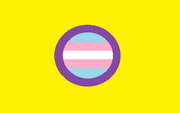
Trans-Intersex by Jesse Bananasaurus/Demi-Dude
"The transgender pride flag has been inserted within the circle of the intersex pride flag to signify the inner identities of intersex people who do not identify with the gender their doctors and/or parents assigned them at birth." - Jesse Bananasaurus/Demi-Dude created in July, 2017.
Genderfluid Flag
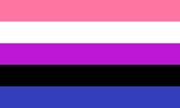
Genderfluid Flag by JJ Poole.
Created in 2012 by JJ Poole (genderfluidity). It has five horizontal stripes which are coloured (top to bottom) pink, white, purple, black and blue. [8]
- Pink for femininity.
- Blue for masculinity.
- Purple for both femininity and masculinity.
- Black for the lack of gender.
- White for all genders.
Agender Flag
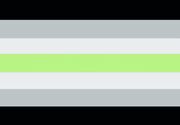
Agender Flag by transrants/Salem X/"Ska"
Created 2014 by Salem X/"Ska". It has seven horizontal stripes which are coloured (top to bottom) black, grey, white, green, white, grey, black. [9]
- Both black and white represent the complete absense of gender.
- Grey represents being semi-genderless.
- Green represents nonbinary gender, because it is the inverse of purple.
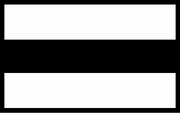
Agender flag by Rumpus Parable
Created 2014 by Rumpus Parable. Simple and clean lined agender flag design.
- Black is to indicate a distinct identity in those without gender. The color black for agender persons is chosen for its correspondence with black being the total absence of color in the light spectrum.
- White acknowledges the historical use as an all-inclusive color for anyone who is non-binary in sex and/or gender and the identity color of black to be placed against to indicate its specific grouping within that traditionally generalized non-binary color.
The two colors have been used alone to intentionally be agender specific without the addition of others usually seen to give reference to gendered identities of any type and aesthetically to create a stark, bold, and simple contrast for the emphasis in the difference and separation from genders expressed and included in other pride flags.
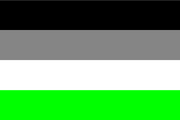
Four-stripe agender flag by AgenderInfo
The four-stripe agender flag is colored (top to bottom) black, gray, white, and neon green. It was created by an agender transgender person as an homage to Salem's original flag, but with bolder stripes and a stronger green, and different color meanings. This flag is always flown with the black stripe on top, to distinguish it from the Aromantic flag, which also appears green, white, and black. The four-stripe agender flag emphasizes inclusion of agender people who may also be lesbian, gay, bi, nonbinary, trans, ace, etc., and their shared feeling of wholeness in genderlessness.
- Black for safety, the night sky, the void.
- Gray for cement and ashes.
- White for bones.
- Green for living, feeling agender.
Pangender Flag
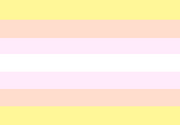
Pangender pride flag proposed by pangendering.
Created in January 2015 by Pangendering. It's based on the agender flag. It consists of seven stripes colored (top to bottom) yellow, light red, violet, white, violet, light red, yellow. The colors are very bright so that they represent the multiplicity of genders (because the white light, in the electromagnetic spectrum, is a combination of all colors).
- Yellow (#fff798) represents all the genders that are not related to female and male.
- Light red (#ffddcd) represents the transition to the genders which are related to female and male.
- Light violet (#ffebfb) represents the combination of female and male.
- White represents the blend of all these genders.
Ingender Flag

Just white. Might be changed to add globe.
As IngenDerism is about the unity of humanity, rather than separating people by their differences, a white flag is used, as all colours are merely part of white.
Pocket Gender Flag
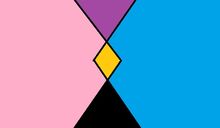
A flag for pocket gender created by our own Alex Stowe. In their own words "... the pink and blue represent masculinity and feminity. They are shaped in (semi) triangles to represent the varying amounts of masculinity and feminity. The purple represents a mix of both (feminity and masculinity and/or genderlessness), the black represents a lack of either or a mix including some form of genderlessness, and the orange represents Maverique, the separation of any gender including genderlessness."
Bigender Flag
Unsure of who created this bigender flag and when, but right now it is one of the most popular flags.
- The white represents trans* identity
- The purple represents no gender

- The pink represents femininity
- And the blue represents masculinity
Other Gender Pride Flags
There are, of course, many other official and proposed pride flags for specific identities throughout the community. Below is a look through a few of them:
- more at pride-flags deviantart.
See also
Peace Flags
